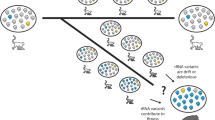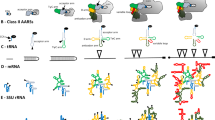Summary
Eukaryotic 5S rRNA sequences from 34 diverse species were compared by the following method: (1) The sequences were aligned; (2) the positions of substitutions were located by comparison of all possible pairs of sequences; (3) the substitution sites were mapped to an assumed general base pairing model; and (4) the R-Y model of base stacking was used to study stacking pattern relationships in the structure. An analysis of the sequence and structure variability in each region of the molecule is presented. It was found that the degree of base substitution varies over a wide range, from absolute conservation to occurrence of over 90% of the possible observable substitutions. The substitutions are located primarily in stem regions of the 5S rRNA secondary structure. More than 88% of the substitutions in helical regions maintain base pairing. The disruptive substitutions are primarily located at the edges of helical regions, resulting in shortening of the helical regions and lengthening of the adjacent nonpaired regions. Base stacking patterns determined by the R-Y model are mapped onto the general secondary structure. Intrastrand and interstrand stacking could stabilize alternative coaxial structures and limit the conformational flexibility of nonpaired regions. Two short contiguous regions are 100% conserved in all species. This may reflect evolutionary constraints imposed at the DNA level by the requirement for binding of a 5S gene transcription initiation factor during gene expression.
Similar content being viewed by others
References
Azad A (1979) Intermolecular base-paired interaction between complementary sequences present near the 3′ ends of 5S rRNA and 18S (16S) rRNA might be involved in the reversible association of ribosomal subunits. Nucleic Acids Res 7:1913–1929
Blanken R, Klotz L, Hinnebusch A (1982) Computer comparison of new and existing criteria for constructing evolutionary trees from sequence data. J Mol Evol 19:9–19
Bogenhagen D, Brown D (1981) Nucleotide sequences inXenopus 5S DNA required for transcription termination. Cell 24:261–270
Bogenhagen D, Sakonju S, Brown D (1980) A control region in the center of the 5S RNA gene directs specific initiation of transcription: II. The 3′ border of the region. Cell 19:27–35
Bubienko E, Cruz P, Thomason J, Borer P (1983) Nearest-neighbor effects in the structure and function of nucleic acids. Prog Nucleic Acid Res Mol Biol 30:41–90
Cantor C, Schimmel P (1980) Biophysical chemistry, part I: the conformation of biological macromolecules. WH Freeman, San Francisco, p 195
Cedergren R, LaRue B, Grosjean H (1981) The evolving tRNA molecule. CRC Crit Rev Biochem 11:35–104
Delihas N, Andersen J (1983) Generalized structures of the 5S ribosomal RNAs. Nucleic Acids Res 10:7323–7344
DeWachter R, Chen M-W, Vandenberghe A (1982) Conservation of secondary structure in 5S ribosomal RNA: A uniform model for eukaryotic, eubacterial, archaebacterial and organelle sequences is energetically favorable. Biochimie 64:311–329
Engelke D, Ng S-Y, Shastry B, Roeder R (1980) Specific interaction of a purified transcription factor with an internal control region of 5S RNA gene. Cell 19:717–728
Erdmann V (1982) Collection of published 5S and 5.8S RNA sequences and their precursors. Nucleic Acids Res 10:r93-r115
Erdmann V, Huysmans E, Vandenberghe A, DeWachter R (1983) Collection of published 5S and 5.8S RNA sequences. Nucleic Acids Res 11:r105-r133
Fox G, Woese C (1975) 5S RNA secondary structure. Nature 256:505–507
Kim S-H, Suddath F, Quigley G, McPherson A, Sussman J, Wang A, Seeman N, Rich A (1974) Three-dimensional tertiary structure of yeast phenylalanine transfer RNA. Science 185:435–440
Kimura M (1980) A simple method for estimating evolutionary rates of base substitutions through comparative studies of nucleotide sequences. J Mol Evol 16:111–120
Kuntzel H, Piechulla B, Hahn U (1983) Consensus structure and evolution of 5S rRNA. Nucleic Acids Res 11:893–901
Luehrsen K, Fox G (1981) Secondary structure of eukaryotic cytoplasmic 5S ribosomal RNA. Proc Natl Acad Sci USA 78:2150–2154
MacKay R, Spencer D, Schnare M, Doolittle W, Gray M (1982) Comparative sequence analysis as an approach to evaluating structure, function, and evolution of 5S and 5.8S ribosomal RNAs. Can J Biochem 60:480–489
Metspalu A, Toots I, Saarma M, Villems R (1980) The ternary complex consisting of rat liver ribosomal 5S RNA, 5.8S RNA and protein L5. FEBS Lett 119:81–84
Nazar R, Wildeman A (1983) Three helical domains form a protein binding site in the 5S RNA-protein complex from eukaryotic ribosomes. Nucleic Acids Res 11:3155–3168
Needleman S, Wunsch C (1970) A general method applicable to the search for similarities in the amino acid sequence of two proteins. J Mol Biol 48:443–453
Novotny J (1982) Matrix program to analyze primary structure homology. Nucleic Acids Res 10:127–131
Pelham H, Brown D (1980) A specific transcription factor that can bind either the 5S RNA gene or 5S RNA. Proc Natl Acad Sci USA 77:4170–4174
Picard B, Wegnez M (1979) Isolation of a 7S particle fromXenopus laevis oocytes: a 5S RNA-protein complex. Proc Natl Acad Sci USA 76:241–245
Pustell J, Kafatos F (1982) A convenient and adaptable package of DNA sequence analysis programs for microcomputers. Nucleic Acids Res 10:51–59
Sakonju S, Bogenhagen D, Brown D (1980) A control region in the center of the 5S RNA gene directs specific initiation of transcription: I. The 5′ border of the region. Cell 19:13–26
Sakonju S, Brown D, Engelke D, Ng S-Y, Shastry B, Roeder R (1981) The binding of a transcription factor to deletion mutants of a 5S ribosomal RNA gene. Cell 23:665–669
Stahl D, Luehrsen K, Woese C, Pace N (1981) An unusual 5S rRNA, fromSulfolobus acidicaldarius, and its implications for a general 5S rRNA structure. Nucleic Acids Res 9:6129–6137
Traub W, Sussman J (1982) Adenine-guanine base pairing in ribosomal RNA. Nucleic Acids Res 10:2701–2709
Troutt A, Savin T, Curtiss W, Celentano J, Vournakis J (1982) Secondary structure ofBombyx mori andDictyostelium discoideum 5S rRNA from S1 nuclease and cobra venom ribonuclease susceptibility, and computer assisted analysis. Nucleic Acids Res 10:653–664
Woese C, Gutell R, Gupta R, Noller H (1983) Detailed analysis of the higher-order structure of 16S-like ribosomal ribonucleic acids. Microbiol Rev 47:621–669
Author information
Authors and Affiliations
Additional information
Communicated by Argiris Efstratiadis
Rights and permissions
About this article
Cite this article
Curtiss, W.C., Vournakis, J.N. Quantitation of base substitutions in eukaryotic 5S rRNA: Selection for the maintenance of RNA secondary structure. J Mol Evol 20, 351–361 (1984). https://doi.org/10.1007/BF02104741
Issue Date:
DOI: https://doi.org/10.1007/BF02104741




